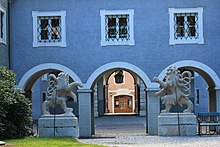New Castle (Gmünd in Carinthia)

The New Castle in Gmünd in Carinthia , also known as Lodron Castle , is located in the southeast corner of the city's main square.
Historical overview of the creation
The New Palace and the Old Palace in Gmünd in Carinthia (see Burg Gmünd ) were for over 500 years in the power struggles of the Salzburg archbishops, initially strategically, then economically and finally family-politically important administrative centers of a manorial power beyond the Katschberg .
With the violent peace in Lieserhofen, dictated by Philipp von Spanheim , elected Archbishop of Salzburg from 1252 to 1253, the diocese of Salzburg ousted the Counts of Gorizia who lived in the Liesertal in the 13th century . The policy of the feeble Archbishop Bernhard von Rohr led to the rule becoming imperial for a short time in 1488. In 1502 the Roman-German king and later Emperor Maximilian I was forced to leave the town and manorial rule of Gmünd to his financier, the Archbishop of Salzburg, Leonhard von Keutschach . The Keutschacher had the destroyed Gmünd Castle rebuilt, doubled and re-fortified.
When the Carinthian estates, dissatisfied with the Salzburg regiment protested, the indebted Maximilian I left the property to his legacy Siegmund von Dietrichstein at the beginning of 1514, and six months later transferred it back to Archbishop von Keutschach and his successor Mathäus Lang for further sums of money from the Salzburg treasury Lifetime. Gmünd continued to be represented in the Salzburg state parliament. Now Emperor Maximilian I pledged the town and rule of Gmünd to the Salzburg keeper Pflügl and made him imperial captain. After his death, the manor came to the Protestant-Evangelical baron Siegmund Khevenhüller.
In 1601 Archbishop Wolf Dietrich forced Gmünd in Carinthia to be given as pledge to his brother Hans Rudolf von Raitenau for 100 years "to propagate the Catholic religion". Under him the last major expansion of the old castle Burg Gmünd began . In 1611 Archbishop Wolf Dietrich was taken prisoner on the run before he could reach Gmünd. When Hans Rudolf von Raitenau died in Gmünd on May 3, 1633, a will stipulated that the manor and city of Gmünd would be left to Christoph Count von Lodron , brother of the Salzburg Archbishop Paris von Lodron . With the permission of Emperor Ferdinand III. The rule became Lodronian in 1639, was under the care of Georg Franz Ebenhoch von Hocheneben around 1700 and was owned by the descendants of the Lodron family until 1932. Christoph Graf Lodron had the New Castle on the market square of the city of Gmünd in Carinthia expanded as a residential and administrative center.
The construction of a city palace in Gmünd in Carinthia began in 1610 by master builder Daniel Deutta for Hans Rudolf von Raitenau, the brother of Salzburg's Archbishop Wolf Dietrich von Raitenau . After the acquisition by Christoph Graf von Lodron, Hereditary Marshal and brother of the Salzburg Archbishop Paris von Lodron , the castle was completed by the local builder Anton Riebeler from 1651 to 1654. In a fire in 1792, the roof structure and the wall paintings on the first floor were badly damaged. The repair work was carried out by master builder Johann Glanner from Werfen. Until 1932 the castle served as the mansion of the Fideikommiss of the Primogeniture of Count Lodron . Thereafter, Karl Irsa acquired the castle with the goods of Lodron'schen Fideikommiss, which he sold to the municipality of Gmünd in 1950. In addition to other structural adaptations, a new top floor was added. Today the castle houses a secondary school, gymnasiums, city halls and a library.
Building
The four-storey castle consists of a three-wing complex around a rectangular inner courtyard. The north wing is connected to the Upper City Gate. A pillar hall leads from the main entrance in the west wing into the courtyard. The Lodron coat of arms is attached to the pediment above the north portal . In the corners of the courtyard are two polygonal, eight-storey stair towers, which are connected by three-part ground-floor arcades, with arched windows above them. The facade is structured, the framed windows have just roofs, the floors are divided by two strips of cornice. The interiors are spacious and high in a transitional style from late mannerism to early baroque . On the east-facing garden front there are two mighty stone lions about 2 meters high on massive plinths. The Lodron's heraldic animals, created around 1670/1680, were originally set up next to the Mirabell Gardens in Salzburg in the garden of the Lodron Primogeniture Palace and were brought to Gmünd to decorate the rather stratified city palace. In honor of the automobile designer Ferdinand Porsche , who lived in Gmünd until 1950 , a memorial bust was set up in the Lodron's castle park, since 1952 "Professor Porsche Park".
See also
literature
- Dehio manual. The art monuments of Austria. Carinthia. Anton Schroll, Vienna 2001, ISBN 3-7031-0712-X , p. 206 f.
- Wilhelm Deuer: Castles and palaces in Carinthia. Verlag Johannes Heyn, Klagenfurt 2008, ISBN 978-3-7084-0307-6 , pp. 191-193.
- Gerhard Stenzel: From castle to castle in Austria. With aerial photographs by Lothar Beckel. Verlag Kremayer & Scherau, Vienna 1976, ISBN 3-218-00288-5 , pp. 130 and 131. (The Salzburg Procedure. Gmünd in Carinthia)
Web links
- Entry via Gmünd (Carinthia) - Castle on Burgen-Austria
Coordinates: 46 ° 54'25.8 " N , 13 ° 32'12.7" E

